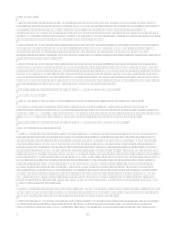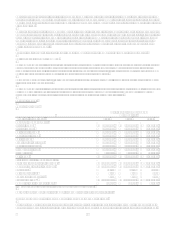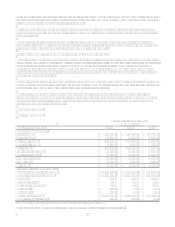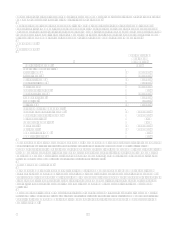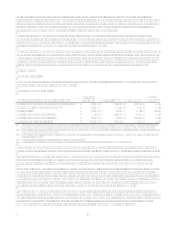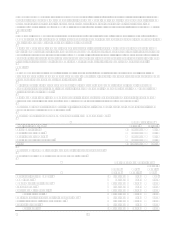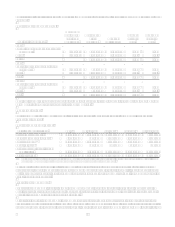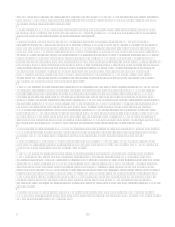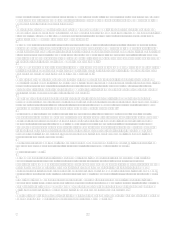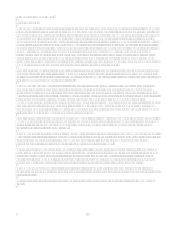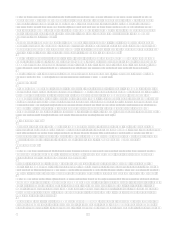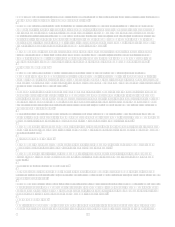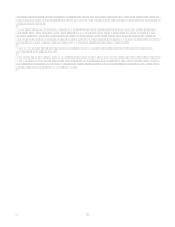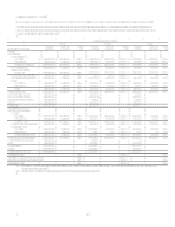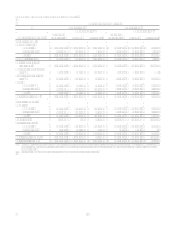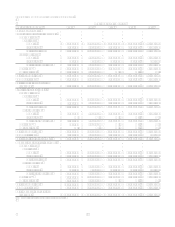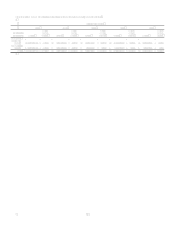Capital One 2006 Annual Report Download - page 68
Download and view the complete annual report
Please find page 68 of the 2006 Capital One annual report below. You can navigate through the pages in the report by either clicking on the pages listed below, or by using the keyword search tool below to find specific information within the annual report. 50
Included in senior and subordinated notes on the Companys balance sheet, the Bank has a global bank note program. Notes
may be issued under this program with maturities of thirty days or more from the date of issue. At December 31, 2006, the
Bank had $3.4 billion in bank notes outstanding.
Subsidiary banks are members of various Federal Home Loan Banks (FHLB) that provide a source of funding through
advances. These advances carry maturities from one month to 30 years. At December 31, 2006, the Company had $2.6 billion
of advances from the FHLBs. All FHLB borrowings are collateralized with mortgage-related assets which may include
residential and commercial mortgages and home equity loans.
The Company also held $6.0 billion in available-for-sale investment securities, net of $9.5 billion in pledged available-for-
sale investment securities and $4.7 billion of cash and cash equivalents at December 31, 2006, compared to $9.2 billion in
available-for-sale investment securities, net of $5.1 billion in pledged available-for-sale investment securities and $4.1 billion
of cash and cash equivalents at December 31, 2005. As of December 31, 2006, the weighted average life of the investment
securities was approximately 3.6 years. These investment securities, along with cash and cash equivalents, provide increased
liquidity and flexibility to support the Companys funding requirements.
The Company has a $750.0 million credit facility committed through June 2007. The Company may take advances under the
facility subject to covenants and conditions customary in a transaction of this nature. This facility may be used for general
corporate purposes and was not drawn upon at December 31, 2006.
On June 6, 2006, August 1, 2006 and February 5, 2007, the Corporation and certain of its subsidiary trusts (Capital One
Capital II, Capital One Capital III and Capital One Capital IV, respectively) completed offerings of trust preferred securities,
representing preferred beneficial interests in the assets of the subsidiary trusts. The proceeds from the sale of the trust
preferred securities to investors, and of certain common trust securities to the Corporation, were invested by the subsidiary
trusts in junior subordinated debt securities of the Corporation.
Simultaneously with the closing of each of these offerings of trust preferred securities, the Corporation entered into a
replacement capital covenant for the benefit of persons that buy, hold or sell a specified series of long-term indebtedness of
the Corporation or certain of its depositary institution subsidiaries. The Company will provide a copy of the replacement
capital covenant to holders of the covered debt upon request made to Investor Relations.
The replacement capital covenants provide that the Corporation will not repay, redeem or purchase, and will cause its
subsidiaries not to repay, redeem or purchase, all or any part of the relevant trust preferred securities or junior subordinated
debt securities prior to a defined termination date except, with certain limited exceptions, to the extent that, during the
180 days prior to the date of that repayment, redemption or purchase, the Corporation or its subsidiaries have received
proceeds from the sale of qualifying securities that (i) have equity-like characteristics that are the same as, or more equity-
like than, the applicable characteristics of the relevant junior subordinated debt securities at the time of redemption or
repurchase, and (ii) the Corporation has obtained prior approval of the Federal Reserve Board, if such approval is then
required by the Federal Reserve Board.
As of the date of this Annual Report, the Corporations 5.35% Subordinated Notes, due May 1, 2014, is the series of long-
term indebtedness whose holders are entitled to the benefits of the replacement capital covenants.
Derivative Instruments
The Company enters into interest rate swap agreements in order to manage interest rate exposure. In most cases, this
exposure is related to the funding of fixed rate assets with floating rate obligations, including off-balance sheet
securitizations. The Company also enters into forward foreign currency exchange contracts to reduce sensitivity to changing
foreign currency exchange rates. The hedging of foreign currency exchange rates is limited to certain intercompany
obligations related to international operations. These derivatives expose the Company to certain credit risks. The Company
has established policies and limits, as well as collateral agreements, to manage credit risk related to derivative instruments.
In April 2006, the Company entered into derivative instruments to mitigate certain exposures it faced as a result of the
expected acquisition of North Fork. The position was designed to protect the Companys tangible capital ratios from falling
below a desired level. The Companys maximum negative exposure was expected to be no more than approximately $50
million. The derivative instruments expired out of the money and unexercised on October 2, 2006.
Additional information regarding derivative instruments can be found on pages 107-109 in Item 8 Financial Statements and
Supplementary DataNotes to the Consolidated Financial StatementsNote 23.


